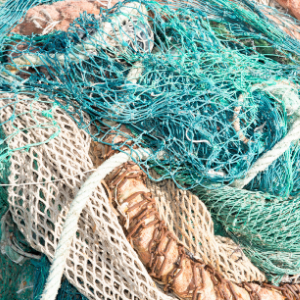By Capt. Nancy Knowlton
If you have not seen the Netflix documentary Seaspiracy, I highly recommend that you do. Released in March 2021 and created by Ali Tabrizi (who also produced Cowspiracy in 2014), this film uses shocking footage, emotion, statistics, and interviews with world experts to uncover the devastation the fishing industry is causing to our planet. The film alerts us to beached whales full of plastic, Japan's dolphin slaughter and continued whaling, sharks killed for shark fin soup, and 70 percent decline in seabirds since 1950.
A major issue covered is bycatch. This term is used to describe the thousands of dolphins, whales, sharks, sea turtles, octopuses, and other types of marine life that are scooped up into huge nets on factory fishing vessels. It is estimated that this "untargeted" sea life amounts to 40 percent of the total annual global catch. Sadly, bycatch is then discarded and left to die.
According to James Hitchings-Hales of Global Citizen, "Sharks kill 12 humans a year, but humans kill 50 million sharks per year." Sea Shepard Conservation Society explains that over 300,000 whales and dolphins are killed each year as a result of fishing nets. The Earth Island Institute states that according to one seafood distributer of the tuna fishing industry, 45 dolphins are killed for every eight tuna caught. And despite the fact that six of seven sea turtle species are near extinction, over 250,000 die annually caught up in nets.
The film also addresses the plastics issue in depth. Plastics are ubiquitous and harming our oceans. About 150 million tons of floating plastic pieces are sinking and breaking down into microplastics that are harming sea life for centuries to come. However, the film points out that plastic straws are not the biggest concern for our oceans; instead, it is the refuse of fishing nets. It is estimated that the Pacific Patch (floating plastic garbage the size of Texas between California and Hawaii) contains 46 percent discarded fishing nets. This is far more dangerous than straws, yet most people do not realize it.
The impacts of ravaging our oceans' health can be devastating. Whales and dolphins fertilize phytoplankton on the ocean's surface each time they come up for air. These tiny plants absorb four times the amount of carbon dioxide than the Amazon Rain Forest! Many climatologists argue: Save the whales, save the planet. In addition, when the top of the food chain is overfished, it continues to overpopulate the next group, upsetting the entire food chain. When we interrupt the ecosystem, our oceans begin to die.
The ultimate warning of the film is that our oceans will be empty by 2050 if we continue on the current trajectory of overfishing. It highlights important considerations like hazardous plastic fishing nets, damage to coral reefs, ocean pollution, impacts of climate change, and the worldwide lack of oversight and regulation on the fishing industry. It also points out the disturbing revelation that sustainable labeling, such as Dolphin Safe or Marine Stewardships Council labels, may not actually be what they claim. Ali Tabrizi followed the money and discovered that the majority of income of these labeling companies comes directly from the sales of their sustainable labeling.
This controversial film will leave you filled with questions. Should I stop eating fish? What does sustainable mean, anyway? Is fish farming a solution? Is the Wild Caught label trustworthy? Why are environmental groups so quiet about overfishing?
It is up to us to unite and solicit lawmakers and scientists to find some of the answers to these challenging questions. We do not have much time.
Learn More:
